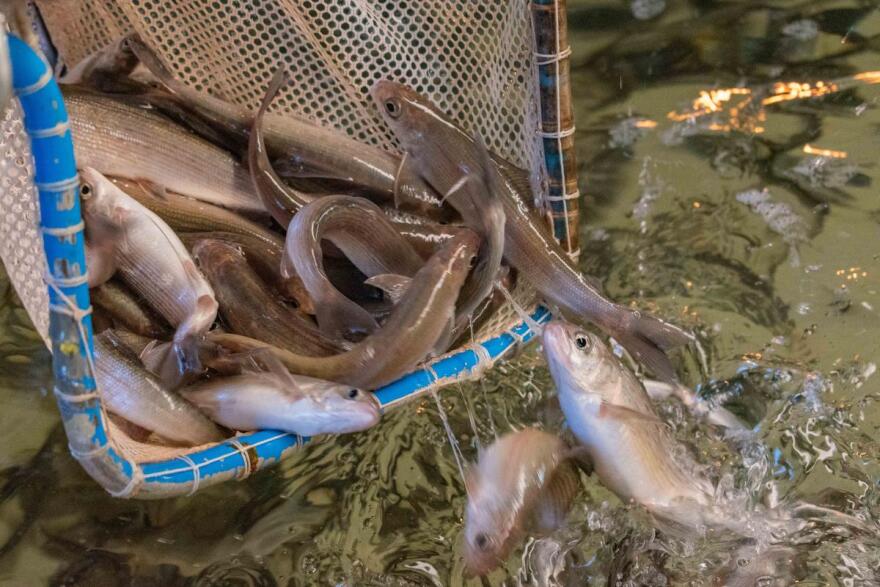For decades, researchers have been trying to bring back this iconic fish to Michigan—the arctic grayling—without success. Now, more than 50 collaborators across Michigan think they’ve finally figured out what makes this fish tick. And they're hoping that means this next attempt at bringing back the arctic grayling has a shot at success.
In a dim, out-of-the-way corner of the state fish hatchery in Marquette are a few thousand skinny, grey fish, each no more than nine inches long.
“They are skittish,” says Jim Aho, who runs the facility for the Department of Natural Resources. “Movement above them definitely puts stress on them, so they’re in a dark, quiet few tanks here.”
The modest fish have captured the interest of dozens of researchers and native species advocates at universities, tribal governments, state agencies, and local businesses across Michigan.
They’re arctic grayling, known as nmégos in Ojibwe— a species that was once dominant in rivers and streams in northern Michigan, before they were wiped out from the state over a century ago.
Since then, people have been trying to bring them back, without success. But researchers think this attempt will be different.
“There’s a lot more will behind it this time, because we don’t want it to fail again,” says Dana Castle, an inland fisheries biologist for the Little River Band of Ottawa Indians.

The young grayling in the state’s hatchery came from Alaska, collected as eggs from a river near Fairbanks and carted back to Michigan by plane.
“They were my little carry-ons,” says Nicole Watson, a fisheries scientist at Michigan State University who hatched the eggs in her lab. “You get plenty of odd looks from other people on the plane when you’re carrying a styrofoam box that says ‘live animals.’”
Once a dominant fish
Watson traveled to Alaska to gather grayling eggs because the state's population is genetically diverse, and no descendants from Michigan’s original population exist.
People exterminated the fish from the state through a combination of overfishing, habitat destruction, and stocking rivers with competing species.
“There’s records of people catching them and putting them up on a pile on the bank, and just leaving them to rot,” Watson says.
The fish were shipped by railcar to restaurants in Chicago and Detroit in the 19th century. And they were a big draw for tourists, because they’re easy to catch.
“And it wasn’t just like going out and catching 10 to 20 fish,” Watson says. “It was going out and catching hundreds of fish, repeatedly over and over.”

At the same time, Michigan’s booming logging industry eroded riverbanks and mucked up streams with silt and sediment. Loggers would float timber by riverways in the spring, “the same time when grayling are trying to spawn and hatch,” Watson says.
And finally, faltering grayling populations had new competition from hatchery-reared brown, rainbow and brook trout, stocked in Michigan streams in the late 1800s.
Facing all these threats, grayling were extinguished from Michigan's lower peninsula by the early 1900s. The final wild fish documented in the state was caught in the Upper Peninsula in 1936.
Why this time is different
Since then, every effort to reintroduce the fish has failed. Researchers kept running in the same problem — soon after they stocked grayling into streams, the fish would disappear.
“When they would go out later to look for them, they didn’t find them,” says Troy Zorn, a fisheries biologist at the Department of Natural Resources.

A major clue to what might have happened comes from research done at Montana State University. There, scientists have raised grayling eggs directly in stream water, not a hatchery. And this method seems to have worked — grayling have come back to reproduce as adults.
Researchers like Zorn suspect that as tiny fish, grayling form a powerful memory of the stream where they’re born, something called imprinting.
“They’re getting a snapshot of the scent of the water, so the chemicals in the water, the signature of the smell of that water,” Zorn explains. “They somehow lock that away in their brain. It’s pretty amazing.”
The theory here is that when grayling are old enough to reproduce, they search out their native waters, following an early memory of its distinct smell.
“Then, they say this is the spot, like X marks the spot,” Zorn says. If the fish are reared in a hatchery, they won’t know where to reproduce.
The next generation
So the grayling originally from Alaska, now at the state hatchery in Marquette, won’t wind up in any Michigan streams. Instead, they’re what’s called broodstock, or the parents of what scientists hope will be Michigan’s future grayling population.
Researchers will head back to Alaska this spring to collect another batch of eggs. When those fish are old enough to reproduce, researchers will cross them with the state's current crop of fish. That way, their descendants won’t have any problems with inbreeding.
Then, biologists will raise the tiny eggs in streams where they think grayling will have the best shot at survival. The hope is that when this next generation of little fish grow up, they’ll return to spawn.
“There’s a decent chance of success, but it’s not a sure chance by a long shot,” Zorn says.
Even if all goes well, it will be years before any grayling eggs make it into state waters. And raising fish in streams, rather than a hatchery, is a more labor-intensive process that’s harder to do at scale.
Then, the little fish will have a lot to contend with, like not becoming lunch.
But there will be plenty of people rooting for them, and abundant cold waters for the fish roam, Zorn says.
“If we can reintroduce grayling, I think they can be around for quite a while.”
This story originally aired on Points North, a weekly show about the land, water and inhabitants of the upper Great Lakes that airs on Interlochen Public Radio.



